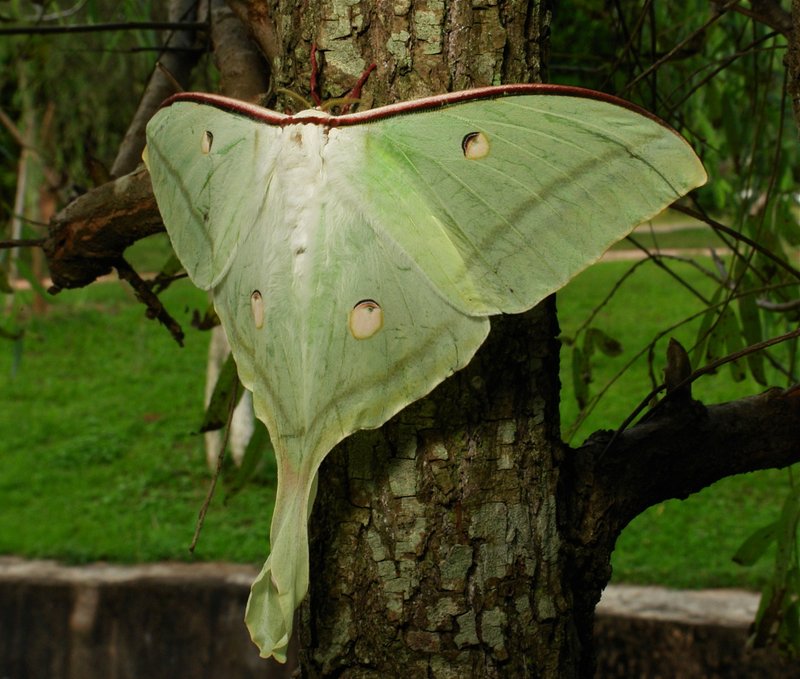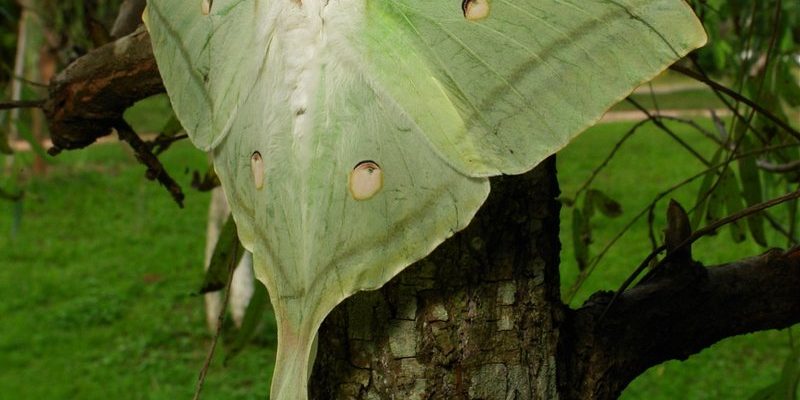
Have you ever seen a creature that looks like it belongs in a fairytale? The Indian Moon Moth is one of those magical beings that can leave you in awe. Known for its stunning appearance and intriguing habits, this moth isn’t just another bug buzzing about your garden. Its vibrant colors and unique shape can make even the most indifferent observers take a moment to appreciate nature’s artistry.
Let’s break down what makes the Indian Moon Moth so special. With a wingspan that can stretch up to 6 inches, they truly live up to their name, resembling the luminous glow of the moon against a dark night sky. Their yellowish-green wings are accented with eye-catching patterns that help them blend into the lush environments of their habitat. But there’s more to this creature than just its looks.
Physical Characteristics
The Indian Moon Moth is often celebrated for its striking appearance. These moths possess large, triangular wings that are adorned with intricate patterns and striking colors. The wings are primarily a pale green or yellow, which helps them blend seamlessly with the foliage in their native habitats. This camouflage is essential for evading predators that might see them as a tasty meal. The eye-catching patterns on their wings resemble the eyes of birds, serving as a clever defensive mechanism.
You might be surprised to learn that the Indian Moon Moth undergoes complete metamorphosis, transitioning from a fluffy caterpillar to a majestic moth. The caterpillars are equally captivating, featuring vibrant hues of green and yellow, dotted with spiny projections that give them a unique, almost alien appearance. When the caterpillar is ready to pupate, it forms a cocoon that further protects it during its transformation.
Habitat and Distribution
The Indian Moon Moth thrives in tropical and subtropical regions, primarily found in parts of India and Southeast Asia. They prefer environments that are rich in vegetation, such as lush forests, gardens, and shrublands. These habitats provide both food and safety during their lifecycle. You might spot them fluttering around trees, especially during the night, as they are nocturnal creatures.
Interestingly, these moths can often be found in areas that are home to a variety of host plants, which are essential during their caterpillar stage. They feed on the leaves of plants such as Guava and various types of fruit trees, which provide the nutrients necessary for their growth and development. As a result, the presence of Indian Moon Moths can serve as an indicator of a healthy ecosystem.
Diet and Feeding Habits
The adult Indian Moon Moth primarily feeds on nectar from flowers, making it a vital player in the pollination process. They are attracted to a range of floral species, often preferring those with strong scents and abundant nectar. This feeding behavior highlights their role in maintaining biodiversity and supporting the growth of various plants in their habitat.
When in the caterpillar stage, however, their diet takes a different turn. These larvae are primarily herbivorous, munching on the leaves of specific host plants. The choice of plants is crucial for their development, as the leaves provide the necessary nutrients to support their transformations. In fact, the caterpillars are quite selective, often staying close to the plants where they hatched. This characteristic shows how tightly interwoven the Indian Moon Moth is within its ecosystem.
Life Cycle of the Indian Moon Moth
The life cycle of the Indian Moon Moth is divided into four stages: egg, larva (caterpillar), pupa (chrysalis), and adult moth. The journey begins when the female moth lays her eggs on the underside of leaves, carefully selecting the right host plants for her offspring. The eggs are tiny and often blend in with the leaf, making them hard to spot for predators.
Once the eggs hatch, the caterpillars emerge, ready to feast on their leafy surroundings. They grow rapidly, shedding their skin multiple times—a process called molting—until they reach their full size. After several weeks of devouring leaves, the caterpillars find a safe spot to pupate, wrapping themselves in a cocoon. Inside this protective casing, they undergo metamorphosis, transforming into the beautiful moths we admire.
Behavior and Adaptations
The Indian Moon Moth has developed several fascinating adaptations that allow it to thrive in its environment. One of the most significant is its ability to remain motionless, mimicking the appearance of leaves or branches to avoid detection. This behavior is critical when predators like birds or lizards are nearby. When they do move, their flight is slow and graceful, making it difficult for predators to catch them.
Another adaptation is their nocturnal nature. As creatures of the night, they have evolved to take advantage of the darkness, which offers them protection from many day-active predators. During the day, they rest in the dense foliage, relying on their camouflaged appearance to stay hidden. This combination of stealth and timing is vital for their survival.
Conservation Status
While the Indian Moon Moth is not currently classified as endangered, habitat loss due to deforestation and urbanization poses a significant threat to their populations. As human activities encroach upon their natural habitats, the availability of food and safe breeding grounds can decrease. Conservation efforts aimed at protecting tropical forests and promoting biodiversity are essential for ensuring the survival of these beautiful moths.
Environmental awareness and education can play a significant role in conservation. By understanding the importance of all species, including the Indian Moon Moth, we can make more sustainable choices that benefit both our ecosystems and the creatures that inhabit them. Supporting local conservation initiatives can also help to preserve the beautiful environments where these moths thrive.
Interesting Facts about the Indian Moon Moth
| Wingspan: | Up to 6 inches |
| Color: | Pale green or yellow with dark patterns |
| Habitat: | Tropical and subtropical forests |
| Diet: | Nectar as adults; leaves of specific plants as caterpillars |
| Lifespan: | Several weeks to a few months |
The Indian Moon Moth is truly a marvel of nature. From its breathtaking appearance to its vital role in the ecosystem, this moth captivates the imagination and serves as a reminder of the beauty that surrounds us. Whether you’re spotting one on a warm summer night or learning about its life cycle, the Indian Moon Moth invites us to appreciate the wonders of the natural world.
FAQ
What is the Indian Moon Moth most known for?
The Indian Moon Moth is primarily known for its striking appearance and large wingspan. With colors that resemble the glow of the moon, it often captures the attention of nature enthusiasts and casual observers alike. Its unique patterns also serve as a camouflage, helping it to blend into its surroundings and evade predators.
How can I spot an Indian Moon Moth in the wild?
Spotting an Indian Moon Moth can be a delightful experience. Since they are nocturnal, your best chances are during the evening or at night in areas with rich vegetation. Look for them around flowering plants where they might be feeding on nectar. Their size and distinctive color make them stand out against dark backgrounds, especially when they flutter softly from flower to flower.
Are Indian Moon Moths harmful to humans?
No, Indian Moon Moths are not harmful to humans. They do not bite or sting, and their presence is generally harmless. They are more beneficial than harmful, as they play a vital role in pollination, contributing to the health of their ecosystems. If you encounter one, simply admire it from a distance, as disturbing it won’t benefit either party.
What do Indian Moon Moth caterpillars look like?
Indian Moon Moth caterpillars are quite distinctive, with vibrant green and yellow colors and spiny projections that give them an alien-like appearance. These features not only make them visually interesting but also serve as a deterrent against potential predators. They feed primarily on the leaves of specific host plants, which provide them the nutrients they need to grow.
How long does the Indian Moon Moth live?
The lifespan of an Indian Moon Moth can vary, but typically, adult moths live for several weeks to a few months. The duration of their life cycle depends on environmental factors and availability of resources. The different stages—from egg to caterpillar to pupa—can also impact their overall lifespan, especially if they encounter adverse conditions during development.
What plants do Indian Moon Moths prefer as host plants?
Indian Moon Moth caterpillars are known to feed on the leaves of various plants, including Guava and some fruit trees. These plants are essential for their growth and development, providing the nutrients needed to support their transformation into adult moths. Understanding these preferences is vital for conservation efforts, as preserving these host plants can help sustain their populations.
Is the Indian Moon Moth endangered?
Currently, the Indian Moon Moth is not classified as endangered. However, habitat loss due to deforestation and urbanization poses a threat to their populations. Conservation initiatives aimed at protecting tropical forests and promoting biodiversity are crucial for ensuring their future. Awareness and education can foster a greater understanding of the importance of these moths within their ecosystems.
Can Indian Moon Moths be kept as pets?
While it’s theoretically possible to keep Indian Moon Moths in captivity, they are best appreciated in their natural environment. These moths have specific habitat needs and dietary requirements that can be challenging to meet in a home setting. Instead of trying to keep them as pets, consider creating a moth-friendly garden to attract them and enjoy observing their natural behaviors.
What role do Indian Moon Moths play in the ecosystem?
Indian Moon Moths play an essential role in their ecosystems primarily as pollinators. By feeding on nectar, they help facilitate the reproduction of flowering plants, which are vital for biodiversity. Their presence can indicate the health of an ecosystem, as they require specific habitats and plant species to thrive. Protecting these moths ultimately contributes to the overall balance of nature.
Are there other types of moon moths?
Yes, there are several species of moon moths found worldwide, not just the Indian Moon Moth. Each species may differ in size, coloration, and habitat preferences. For instance, the Luna Moth found in North America is another fascinating example of a moon moth, known for its pale green wings and long tails. All moon moths share certain characteristics, but each brings its own unique beauty to the realm of moths.

